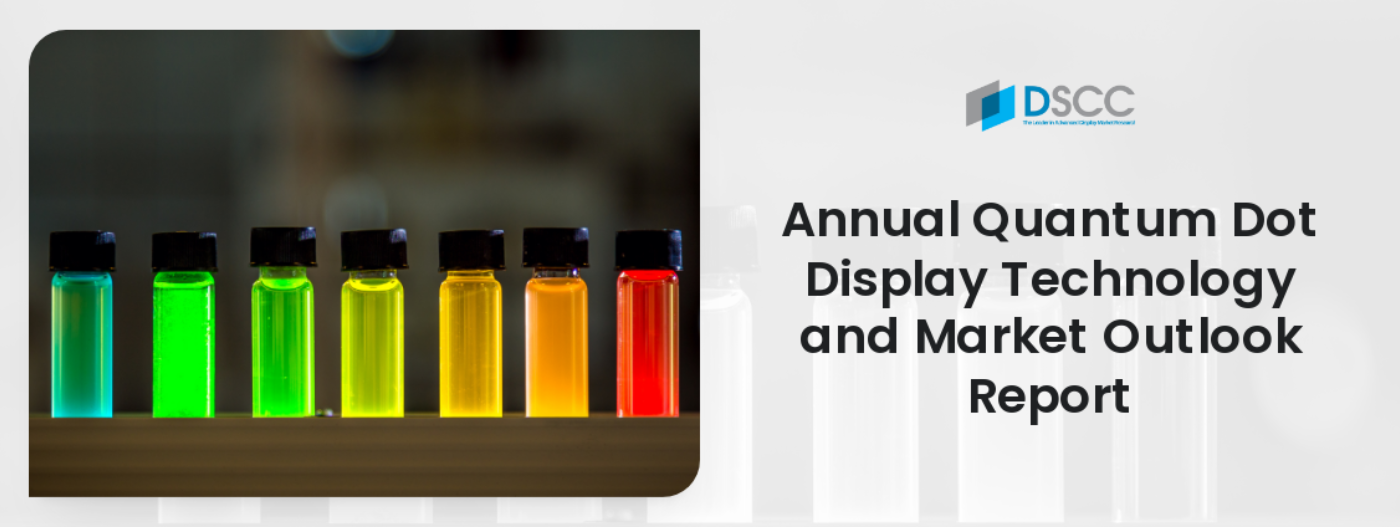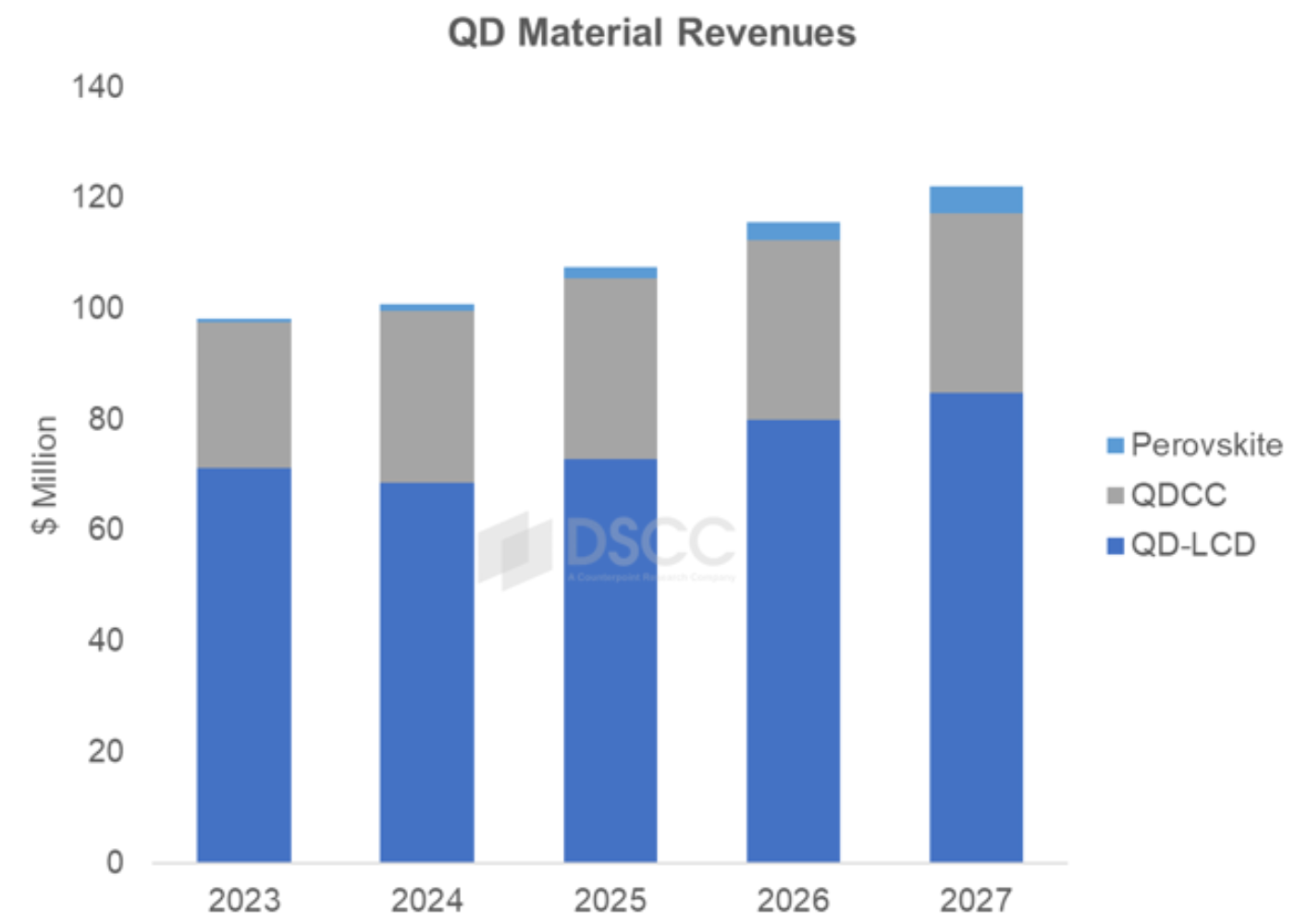量子ドット (QD) 出荷額が過去最高を更新~プレミアムディスプレイ需要が後押し
出典調査レポート Quantum Dot Display Technology and Market Outlook Report の詳細仕様・販売価格・一部実データ付き商品サンプル・WEB無料ご試読は こちらから お問い合わせください。
これらDSCC Japan発の分析記事をいち早く無料配信するメールマガジンにぜひご登録ください。ご登録者様ならではの優先特典もご用意しています。【簡単ご登録は こちらから 】
記事のポイント
• QD市場は2024年の1億ドルから2027年には1億2200万ドルに拡大する
• QD-OLED生産向け材料消費が現在の出荷額の31%を占める
• ペロブスカイト技術とEL-QD技術が今後の新たな成長機会となる
DSCCの Quantum Dot Display Technology and Market Outlook Report 最新版によると、ディスプレイパネル用量子ドット材料の出荷額が今年、1億ドルを超える見通しだ。TVやモニターにおけるMiniLEDやQD-OLEDといった技術の台頭により、量子ドット需要は伸び続けている。2027年には出荷額が1億2200万ドルに達するとDSCCは予測している。
同レポートの主筆アナリストであるGuillaume Chansinは次のように述べている。「2022年の登場以来、QD-OLEDはTVディスプレイ技術として最も高く評価されている。生産能力はまだ限られており、2024年に生産されるQD-OLEDは200万枚にとどまるだろう。生産量は少ないものの、QD-OLEDは材料消費の増加に大きく貢献しており、現在では量子ドット出荷額の31%を占めている」
QD-OLED製造では、Samsung Displayが量子ドットカラー変換 (QDCC) 層採用の先駆者となっている。QDCCは量子ドットを含んだインクによって製造時に各ピクセルにインクジェット印刷される。QD-LCDに比べ、QD-OLEDは面積あたりの量子ドット必要量が大きくなる。
同レポートはまた、ペロブスカイト材料がある程度の市場シェアを獲得すると予測している。ペロブスカイトは優れた性能を提供できることから、新たな階級の量子ドットと言われることも多い。緑色ペロブスカイトは利用可能だが、赤色ペロブスカイトはまだ開発中のため、赤色蛍光体と組み合わせた使用も多い。この技術は現在商用化の初期段階にあり、サプライチェーン構築には時間がかかりそうだ。
量子ドットディスプレイの最大のライバルはやはりOLEDである。LG Displayは白色OLED技術の改良を続けており、Samsungとの供給契約にも合意している。消費者はスマートフォン用ディスプレイと同等の高コントラストと広色域を求めることから、OLEDの採用はノートPCでも急速に拡大している。
OLEDと競合する可能性を秘めているのが、エレクトロルミネセンス量子ドット (EL-QD) である。QD-OLEDとは異なり、この技術では量子ドットは色を変換するのではなく直接発光するため、青色OLEDスタックを必要としない。CES2024ではNanosysとSharpがEL-QDディスプレイの新たなプロトタイプを展示していた。近い将来の量産予定はないものの、EL-QD技術が2027年以降の量子ドット材料の伸びを実現することも考えられる。
Quantum Dot Display Technology and Market Outlook Report 2024年版には最新の市場予測に加え、以下のトピックに関する分析を収録している。
- ディスプレイ用途に有効な各種QD
- 欧州連合特定有害物質使用制限指令 (RoHS) の必須事項と各種QDアーキテクチャへの影響
- 量子ドットフィルムと量子ドット材料のコスト内訳および出荷額予測
- フォトリソグラフィーとインクジェット印刷によるQDCC製造の利点と課題
- ペロブスカイトの進捗
- QD-OLEDの生産能力とディスプレイ構造
- MicroLEDにおけるQDCCのアプリケーション
- EL-QDの進捗 (デモ、EQE、ライフタイム)
出典調査レポート Quantum Dot Display Technology and Market Outlook Report の詳細仕様・販売価格・一部実データ付き商品サンプル・WEB無料ご試読は こちらから お問い合わせください。
[原文] Demand for Premium Displays Pushes Quantum Dot Revenues to New Highs
- Quantum dot market to expand from $100M in 2024 to $122M in 2027.
- Material consumption for QD-OLED production now accounts for 31% of revenues.
- Perovskite and EL-QD technologies offer new opportunities for future growth.
Revenues for quantum dot materials in display panels will top $100M this year, according to DSCC’s latest Quantum Dot Display Technology and Market Outlook Report. Demand for quantum dots continues to grow, thanks to the rise of MiniLED and QD-OLED technologies in TV and monitors. DSCC forecasts that revenues will reach $122M by 2027.
“Since its launch in 2022, QD-OLED has become the most highly rated display technology for TV” says Guillaume Chansin, lead analyst on the report. “Capacity remains limited so we expect only 2M QD-OLED panels will be produced in 2024. Despite the small volume, QD-OLED has significantly helped boost material consumption and now accounts for 31% of quantum dot revenues.”
To make QD-OLED panels, Samsung Display has pioneered the use of quantum dot color converters (QDCC). These are inkjet printed on each pixel during manufacturing, using ink formulations that are loaded with quantum dots. Compared to QD-LCD panels, QD-OLED requires a larger quantity of quantum dots per area.
The report also predicts perovskite materials capturing some market share. Perovskites are often described as a new class of quantum dots because they offer better performance. Green perovskite is available but red perovskite is still under development, so it is often paired with a red phosphor. The technology is currently in the early stage of commercialization and the supply chain will take some time to build.
OLED remains the biggest rival to quantum dot displays. LG Display continues to improve its White OLED technology and has even agreed to a supply deal with Samsung. OLED adoption is also growing rapidly in laptops as consumers seek the same high contrast and wide color gamut of a smartphone display.
The potential contestant against OLED is electroluminescent quantum dots (EL-QD). Unlike QD-OLED, this technology does not require a blue OLED stack since the quantum dots emit light directly instead of converting colors. At CES 2024, Nanosys and Sharp were demonstrating new prototypes of EL-QD displays. While there is no plan for mass production in the near future, EL-QD technology could enable growth in quantum dot materials beyond 2027.
The latest Quantum Dot Display Technology and Market Outlook Report includes updated market forecasts, as well as an analysis on the following topics:
- Different types of QDs that are useful for display applications.
- The European Union's Regulatory of Hazardous Substances (RoHS) imperative and implication in each type of QD architecture.
- Cost breakdown and revenues forecasts for quantum dot films and quantum dot materials.
- Advantages and challenges of manufacturing QDCC by photolithography and inkjet printing.
- Progress in perovskites.
- QD-OLED fab capacity and display structure.
- Applications of QDCC in MicroLED displays.
- Progress in EL-QD (demos, EQE and lifetime).

